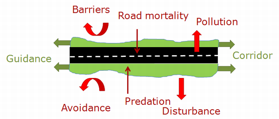Environmental Impact Assessment
Oosterweelverbinding, Antwerp, Belgium
Antwerp, one of the major harbours in the world is a turning point for national and international transport. Like many larger cities, traffic congestion is an everyday problem. However, recently the congestion has taken on proportions that severely impedes local, national and international economic growth and causes severe health and livability issues . To solve this problem, a multitute of measures are proposed (increase public transportation, enhance livability and complete the lase fourth of the circuitous bypass around Antwerp. Especially this last proposal, where a large six-lane motorway with a multitude of ramps and tunnels is to tbe constructed through, past, under and over a nature area, a european birds directive area (Blokkersdijk), a ramsar area (the Schelde) and a densly populated city district, repectively, is followed closely by the media and politicians alike.
In an Environmental Impact Report, I analysed the multitude of different effects a road can have on nature. Among others, the following aspects were calculated:
- loss of habitat
- barrier effects
- road mortality
- pollution
- avoidance
- disturbance
- ...
Combining Ecology and Economy
 Loss of habitat was considered during and after the construction, including temporary and permanent effects like groundwater level, soil type changes etc....
Also disturbance during and after construction was an important factor, including also effects cause by sound and lights.
Because of the importance of the project and the project area (both economically and ecologically), the expertise of an ecologist was brought
in at the very beginning of the planning phase. This enabled fruitfull dicussions in every phase of the project:
Loss of habitat was considered during and after the construction, including temporary and permanent effects like groundwater level, soil type changes etc....
Also disturbance during and after construction was an important factor, including also effects cause by sound and lights.
Because of the importance of the project and the project area (both economically and ecologically), the expertise of an ecologist was brought
in at the very beginning of the planning phase. This enabled fruitfull dicussions in every phase of the project:
- from the positioning of the temporary workplaces, linked to the conversion of poplar plantations to broadleaf forest
- to the positioning of the actual roads, in order to safeguard especially valuable and sensitive areas,
- the re-use of abandoned and overgrown concrete in order to improve surrounding nature reserves and save material costs
- the use of excess earth to create effective sound barriers
- the excavation of sand deposits from tidal mudflats, again to save material and transportation costs and create valuable habitats
- and much more...
This project proved that, if ecological expertise is integrated in the planning process, not only can the total impact be reduced dramatically, win-win situations between economy and ecology can be identified and ecology & economy can go hand-in-hand.

